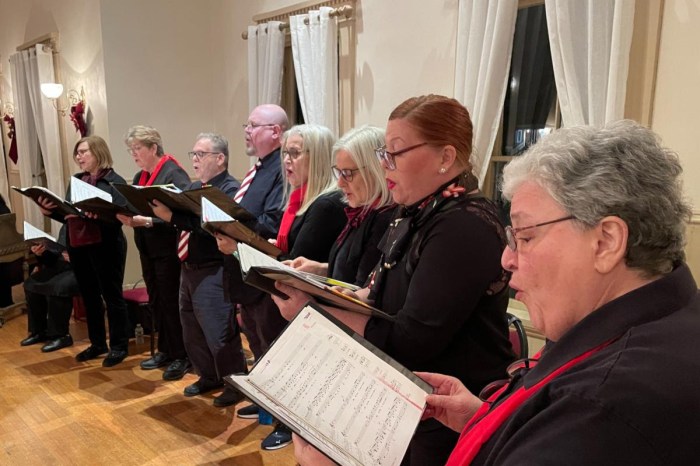Famous Civil War Ship Made In Brooklyn
Historians and Civil War buffs will converge in Greenpoint this weekend for a variety of events to celebrate the 150th anniversary of the launching of the USS Monitor, the ironclad warship produced in the Brooklyn neighborhood that engaged in the most famous naval battle of the conflict between the North and the South.

The weekend of activities is being organized by the Sons of Union Veterans of the Civil War National Sesquicentennial in conjunction with the New York chapter of the organization, the Oliver Tilden Camp 26, the 83rd New York Volunteers Sons of Veterans Reserve, the Greenpoint Monitor Museum and the John Ericcson Society.
Leading off the festivities will be a history fair on Saturday, Jan. 28, from 10 a.m. until 3:30 p.m. at the Capital One Bank branch located at 807 ManhattanAve. at Calyer Street. Visitors will have a chance to visit this free event and view a variety of displays on the Monitor as well as learn more about the ship from guest speakers.
The bank itself was built by Thomas Fitch Rowland, one of those who contributed to the construction of the Monitor and the first trustee of Greenpoint Savings Bank, which was later merged with North Fork Bank and later Capital One Bank.

Later on Saturday evening, residents are invited to attend a Civil War memorial concert from 7 to 8:30 p.m. at the Church of the Ascension, located at 127 Kent St. The event will be preceded by a wine and cheese hour for guests beginning at 6 p.m.
Rowland also contributed funding toward the construction of the Church of the Ascension, which will also host a memorial service at 10 a.m. Sunday morning, Jan. 29, in honor of the crew, contractors and all those who had a hand in the creation and operation of the Monitor.
Following the service and a brief coffee hour, participants will march in a parade from the house of worship to the site where the Monitor was launched on Quay Street off Franklin Street, adjacent to the Bushwick Inlet. A memorial service will be held at the launch site at 12:30 p.m.
The sponsors of the weekend of anniversary activities will hold a reception at the Grand Prospect Hall, located at 263 Prospect Ave. in Prospect Heights beginning at 4 p.m. Tickets may be purchased by calling the Greenpoint Monitor Museum at 1-718-389-7700.
Finally, on Monday, Jan. 30-the actual anniversary of the date the ironclad vessel was launched in Greenpoint-the societies will hold a wreath-laying ceremony at 9 a.m. at the memorial sculpture in Msgr. Mc- Golrick Memorial Park, which is located off the corner of Driggs Avenue and the road named in the ship’s honor, Monitor Street. From there, visitors will have a chance to participate in a “Civil War Bus Tour” of historic sites in Brooklyn and Manhattan commemorating individuals and companies linked to the Monitor.
The development of the Monitor was ordered by the Union Navy in October 1861 after receiving information that the Confederate Navy was building an ironclad ship known as the CSS Virginia out of the remains of the USS Merrimack, which had been partially burned at the Gosport Navy Yard in Norfolk, Va.
In a matter of weeks, work began on the hull of Monitor at the Continental Iron Works in Greenpoint. Its steam engine and related parts were built at the DeLamater Iron Works in Manhattan.
The ship-designed by John Ericsson, a Swedish engineer and inventor, whose model was compared to a “cheese box”-featured many characteristics that were considered innovative for its time, including an armored gun turret that rotated in a complete circle. Like an iceberg, much of the ship floated below the surface, with only the armored deck and turret visible while on the open water.
Completed in about four month’s time, the Monitor was launched from the Bushwick Inlet on Jan. 30, 1862 and was formally commissioned by the U.S. Navy into active duty less than a month later.
The Monitor took her place in American naval history during the Battle of Hampton Roads on Mar. 9, 1862, a day after the Confederacy’s ironclad Virginia attacked the Union blockade near the entrance to Chesapeake Bay. During the attack, the Virginia sank two Union warships, the USS Cumberland and the USS Congress. A third ship, the USS Minnesota, ran aground and was stranded.
Towed into the area of the battle, the Monitor first engaged with the Virginia on the morning of Mar. 9, 1862 as the Confederate ship attempted to destroy the disabled Minnesota. The Monitor endured a four-hour battle with the Virginia, but despite numerous attempts to shoot or ram the other ship into defeat, neither vessel sank or was seriously damaged.
A shot fired by the Virginia struck the Monitor’s pilothouse, causing the Union ship to turn around. According to published accounts, the crew of the Virginia had planned to turn their attention back to the Minnesota, but the captain instead decided to bring the Confederate ship back to Norfolk for repairs.
Upon discovering that the Virginia was on her way back to her home base, the Monitor turned back toward the Minnesota to guard her from further attack.
Considered from a purely tactical standpoint as a draw, many historians would later determine that the Battle of Hampton Roads was a strategic victory for the Union, as it prevented the Confederacy from destroying much of the Union fleet and gaining control of the Chesapeake Bay’s entrance. With the blockade still in place, the Confederate States were unable to receive supplies and other forms of assistance from Europe.
The second and final meeting between the Monitor and Virginia took place on May 8, 1862, as the Union attacked Confederate posts at Sewell’s Point, Va. The Virginia was anchored at the post but abandoned three days later as Confederate forces retreated under the Union barrage.
With the Confederate ship now out of the picture, the Monitor helped other Union naval forces attack the Confederate capitol of Richmond, Va. under the direction of Gen. George McClellan. But the attack was shortlived, as the ships were unable to breach any of the Confederate forts located off the James River; the Union fleet eventually retreated.
Mother Nature, however, did what the Confederate Navy couldn’t do by sinking the Monitor during the winter of 1862. The ship was being towed by the USS Rhode Island during a storm when waves brought the ironclad ship down off the coast of Cape Hatteras, N.C. Sixteen members of the Monitor’s crew died.
The wreckage was discovered by deep-sea divers off Cape Hatteras in the 1970s and was declared as the first U.S. marine sanctuary. Pieces of the ship, as well as the remains of two of her crew members, have since been recovered by the U.S. Navy during dives over the years.
For more information on this weekend’s anniversary celebration in Greenpoint, call George J. Weinmann of the Oliver Tilden Camp 26 at 1-917-832-9999 or Janice Lauletta- Weinmann of the Greenpoint Monitor Museum at 1-718-383-2637.
Editor’s note: Historical information regarding the Monitor was obtained through various online sources.


































